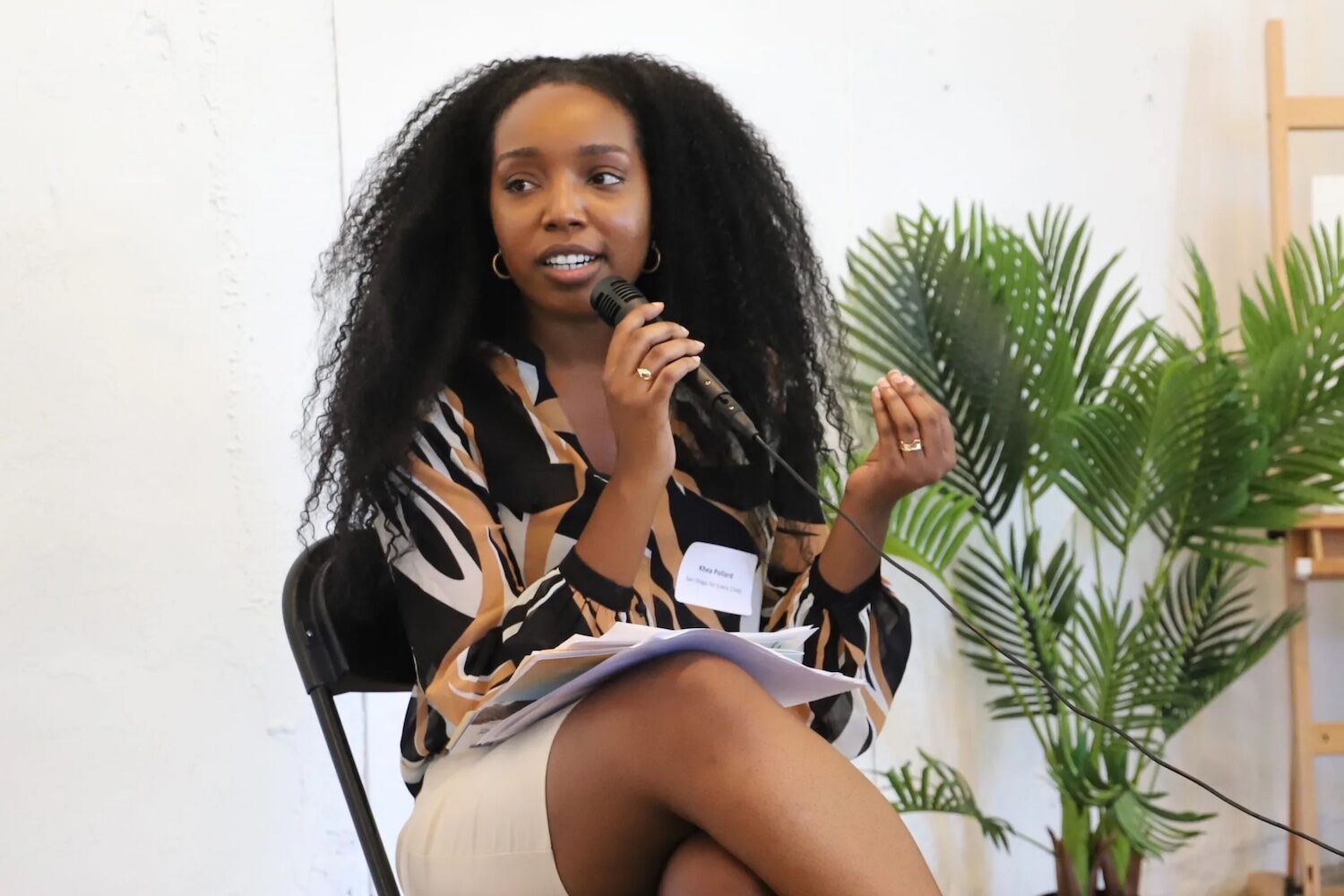
Khea Pollard, director of economic mobility and opportunity at Jewish Family Service of San Diego, moderated an Aug. 25 panel about the Black Women’s Resilience Project.
Photo by Jesse Marx, Voice of San Diego
Name a physically demanding job and it’s probably on Kelvin Marshall’s resume. He’s been in the workforce for decades but struggled to keep pace with San Diego’s extreme cost of living when the pandemic hit.
The single dad was selected earlier this year for a program experimenting with a different kind of assistance known as guaranteed income. Contrary to most other forms of welfare, this one can be spent on whatever he wants.
The Marshalls are one of 150 local families in the pilot led by San Diego for Every Child, a nonprofit sponsored by Jewish Family Service. Those households make less than $53,000 a year and have a child under 12. They must also reside in Encanto, Paradise Hills, San Ysidro or National City — zip codes experiencing high levels of poverty, food insecurity and environmental health concerns.
Marshall used his $500 a month to buy backpacks for his daughters as well as clothing, shoes and food. The direct-cash payments haven’t alleviated all the financial pressure in the household, but it has certainly helped.
“We’re not living beyond our means,” he said. “We’re just living where we’re supposed to be.”
That non-punitive approach runs counter to the way that public benefits are traditionally managed in the United States. But unlike universal basic income — a more widely known proposal offering to send checks to everyone regardless of demographics in the face of an increasingly automated workforce — guaranteed income programs are targeted to specific groups of people.
For now, it’s essentially a research project, and whether it’s ever brought to scale at a government level remains an open question. But it is, in the meantime, expanding to include more communities.
The pilot began in March and is scheduled to last two years. In addition to providing short-term financial support, it’ll add to a growing body of data out of the University of Pennsylvania on the health, education and economic impacts of cash assistance programs as they become more common.
Income Movement, another nonprofit based in Portland, Oregon, has counted more than 80 programs in the United States that are active or in the planning stages. Stockton is one of the most well-known examples but the idea goes back decades. Since the 1980s, in fact, Alaska has distributed energy dividends to its residents.
Though the size and scope of the programs differ, their underlying purpose is to make welfare — often invasive and humiliating, in the ostensible yet dubious name of rooting out fraud — more accessible.
Restrictions on welfare programs can also simply be administratively onerous. Under federal rules, for instance, SNAP recipients cannot buy hot or ready-to-eat meals from grocery stores or restaurants. That’s not the case for homeless, disabled or elderly recipients of CalFresh, but only if the funds are spent at an authorized business.
The advocates of guaranteed income are trying to do away with all that by creating a distribution model based on trust and the belief that people in need know best how to provide for their own families.
A survey of the first three months of the guaranteed income pilot in San Diego shows that recipients spent 41 percent of the money on food. Another 23 percent of it offset retail costs, 20 percent went to transportation and 9 percent was spent on utilities and other household expenses. Nearly half the recipients are Latino and more than a quarter are Black. About two-thirds are women.
Lawmakers in Sacramento, including Sen. Ben Hueso, got the program rolling with $1.4 million in the state budget. Two others are in the works.
Last week, the County Board of Supervisors set aside $7.5 million in federal stimulus funds to put a second pilot in motion. Once the contracts are signed, it’ll provide cash assistance to parents or guardians who’ve been reported for general neglect, meaning the child lacks basic things like food, clothing and shelter. Often the child is left unsupervised because their caretaker is at work.
There are obvious moral and ethical reasons for keeping families together, Supervisor Terra Lawson-Remer told me, but by intervening early the county will also stop kids from entering the foster system and save the Child Welfare Services Department money. In other words, the thinking goes, the county spends a little upfront rather than a lot in the future to repair the damage of an impoverished home.
Or as she put it: “An ounce of prevention is worth a pound of cure.”
A third pilot is taking shape at the cooperative coffee shop Café X: By Any Beans Necessary. Known as the Black Women’s Resilience Project, it’ll test the importance of income as a social determinant in Black households. By and large, people of color were excluded from the social democratic reforms of 20th Century America that helped older, White communities of today build generational wealth.
“Centering women, black women specifically, in the economy helps us build economic security,” said Khea Pollard, director of economic mobility and opportunity at Jewish Family Service of San Diego and co-owner/founder of the coffee shop.
The seed funding for that program is coming from the Alliance Healthcare Foundation, which sees a link between racial income gaps and healthcare overall, brought on by lifetimes of stress. Studies have shown, for instance, that Black and Native women experience much higher rates of maternal and infant mortality than their White counterparts. An approximate 10 percent increase in income during pregnancy has resulted in reductions of low birth weight and preterm birth.
Despite the connection between material support and childcare, a common question that Alliance Healthcare Foundation executive director Sarah Lyman said she hears from philanthropists is “won’t this incentivize people to work less?”
The evidence suggests otherwise. Recipients in Stockton continued to be employed and used the additional money every month as a buffer to go back to school or seek better jobs. Employment actually increased 12 percent.
Another common question Lyman said she’s asked is, Why doesn’t the government fully fund a guaranteed income program and what happens when it ends? So far, the pilots under the Jewish Family Service umbrella draw from a mix of public and private sources, which is why Catalyst of San Diego & Imperial Counties, a funders network, organized a tour of the various programs last month. That’s where I met Marshall and others, including representations from philanthropy groups and governments.
The more immediate problem facing the backers of guaranteed income, however, is how the payments are categorized by public agencies. California treats direct-cash transfers as unearned income, meaning it counts toward a family’s overall assets and can make the applicant ineligible for other benefits.
Melissa Perez, a full-time community college student and mom, said she recently reapplied for CalWorks but the county deducted $500 — the amount of her monthly guaranteed income payment — from her overall allotment. She said officials were hostile when she appealed.
“I’m not trying to steal from anyone,” she said.
The county, according to communications director Michael Workman, has applied for a waiver through the state so what happened to Perez doesn’t happen long term. In an email, he said recipients of guaranteed income should be aware of “potential unintended eligibility impacts to public benefit programs.”
Leaving aside the bureaucratic hurdles, there are also political considerations. The average annual household income for the participants in the first pilot is around $30,000. Many of those folks work minimum wage jobs and so it could be argued that a cash payment doesn’t fundamentally change their labor relations — indeed, the transfers let employers who don’t pay a living wage off the hook.
I tossed the critique at a few of the advocates I met on the tour and they all told me essentially the same thing: Yes, there’s a tension with the labor movement and basic income programs more generally, but you can give cash assistance to low-income people while also empowering them in the workplace. It’s not an either/or.
Stacey Rutland, founder and president of the Income Movement, pointed to research out of Stockton showing that considerable numbers of people who received cash assistance moved from part time to full time work. Some had been doing informal work that isn’t easily organized. Some bought a car and took a better job a little further away. Others bought a nice suit for an interview.
“It’s just an opportunity to support a really broad range of society members who are navigating the realities of their life,” she said. “It gives them autonomy and freedom to cover the things they need.”
Similarly, Chris Olsen, chief of staff at Jewish Family Service, told me that cash assistance and raising the income floor through wages are both worthy goals but separate from what they’re trying to accomplish here.
“Guaranteed income programs are happening now and they’re fast and helping people in need … by filling in gaps with existing social safety net programs,” he said. “The one doesn’t negate the need for the other.”
Perez said food insecurity is a real problem in her home and she stumbled upon the pilot while searching online for help after losing her job. In the beginning, she only let a select group of close friends know about it and they kept telling her how lucky she was for being selected.
“How am I lucky?” she countered. “I was hungry and had no food.”
Marshall got a different reaction.
He said his friends gave him grief for always wanting something for nothing. He felt guilty at first, but the person helping him with the application pointed to all the jobs he’s held over the past 32 years — cleaning floors and carpets, working in warehouses and on construction sites.
“This is what you paid into,” he remembered the social worker saying. “And now that you need it, you have a right to come and see if you can get it.”
This story was first published by Voice of San Diego. Sign up for VOSD’s newsletters here.










